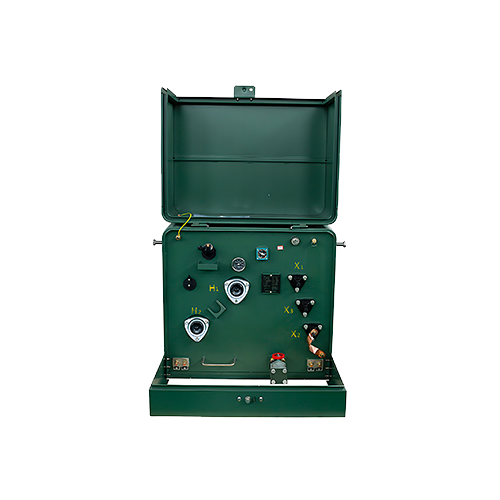
The Singe Phase Pad Mounted Transformer is a compact power distribution device that converts high-voltage electrical energy into low-voltage electrical energy and is widely used in the power system. Its core function is to achieve the conversion of voltage levels through a transformer, thus providing stable and reliable low-voltage electrical energy for end users. Due to its compact structure, flexible installation, and simple operation and maintenance, the Single Phase Pad Mounted Transformer occupies an important position in the modern power distribution system, especially suitable for scenarios where the load is scattered and the power supply distance is long.
The working principle of the Single Phase Pad Mounted Transformer is based on the law of electromagnetic induction, and the conversion of electrical energy from the high-voltage side to the low-voltage side is achieved through a transformer. Its core structure includes key components such as a transformer, a high-voltage load switch, a fuse, and a low-voltage power distribution unit. The high-voltage electrical energy is connected to the primary winding of the transformer through the high-voltage load switch. Through the action of electromagnetic induction, the voltage is reduced to the required low-voltage level, and then it is distributed to the user side through the low-voltage power distribution unit. The high-voltage load switch and the fuse play a protective role in the system to ensure the safe operation of the equipment in case of overload or short circuit.
According to their uses, Single Phase Pad Mounted Transformer can be divided into types such as urban power distribution, rural power distribution, and industrial power distribution. Urban power distribution substations mainly serve residential areas and commercial areas, with the characteristics of concentrated load and high requirements for power supply reliability; rural power distribution substations are suitable for remote areas with scattered loads and long power supply distances; industrial power distribution substations provide power support for high-power power consumption places such as factories and mines. Classified by structure, Single Phase Pad Mounted Transformer can be divided into two types: compact and modular. The compact substation is small in size and easy to install, suitable for places with limited space; the modular substation has the advantages of strong expandability and convenient maintenance. Classified by installation method, it can be divided into pole-mounted installation and ground-mounted installation. Pole-mounted installation is suitable for scenarios with limited space, while ground-mounted installation is more suitable for large-capacity requirements.
When designing a Single Phase Pad Mounted Transformer, key parameters such as voltage level, rated capacity, and short-circuit capacity need to be comprehensively considered. The voltage level determines the application range of the substation, and common levels usually include 10 kV/0.4 kV, 35 kV/0.4 kV, etc.; the rated capacity directly affects its power supply capacity, and it needs to be reasonably selected according to the load demand; the short-circuit capacity is related to the safety and stability of the equipment, and it is necessary to ensure that the substation can withstand the impact of the system short-circuit current. In terms of material selection, the transformer core usually uses cold-rolled silicon steel sheets with high magnetic permeability to reduce iron loss and improve efficiency; the windings use copper conductors or aluminum conductors. Copper conductors have lower resistivity and higher current-carrying capacity, while aluminum conductors have a cost advantage. In terms of manufacturing process, attention needs to be focused on the winding precision of the windings, the insulation treatment process, and the overall assembly quality to ensure the reliability and durability of the equipment.
The performance parameters of a Single Phase Pad Mounted Transformer mainly include rated voltage, rated current, rated capacity, and efficiency. The rated voltage and current determine its power supply capacity and need to match the requirements of the power distribution system; the rated capacity reflects its load capacity, usually in kVA; efficiency is an important indicator for measuring the economy of its energy conversion, and a high-efficiency substation can significantly reduce operating losses. In terms of thermal performance, temperature rise and cooling method are key indicators. Excessive temperature rise will cause the aging of insulating materials and affect the service life of the equipment. Therefore, it is necessary to control the temperature rise through reasonable cooling design (such as natural cooling, forced air cooling, or oil-immersed cooling). In addition, mechanical properties such as seismic capacity and short-circuit resistance are also important considerations, especially in earthquake-prone areas or systems with large short-circuit currents.
As the core equipment of the power distribution system, the Single Phase Pad Mounted Transformer plays an irreplaceable role in the conversion and distribution of electrical energy. Its compact structure, flexible installation method, and reliable operating performance make it widely used in urban, rural, and industrial power distribution fields. In the future, with the continuous growth of power demand and the continuous progress of technology, Single Phase Pad Mounted Transformer will develop in the direction of intelligence, high efficiency, and energy conservation. For example, by integrating an intelligent monitoring system to achieve remote monitoring and fault diagnosis, or by using new materials and technologies to further improve efficiency and reliability. These technological advancements will provide stronger support for the safe and stable operation of the power distribution system and also inject new impetus into the sustainable development of the power industry.